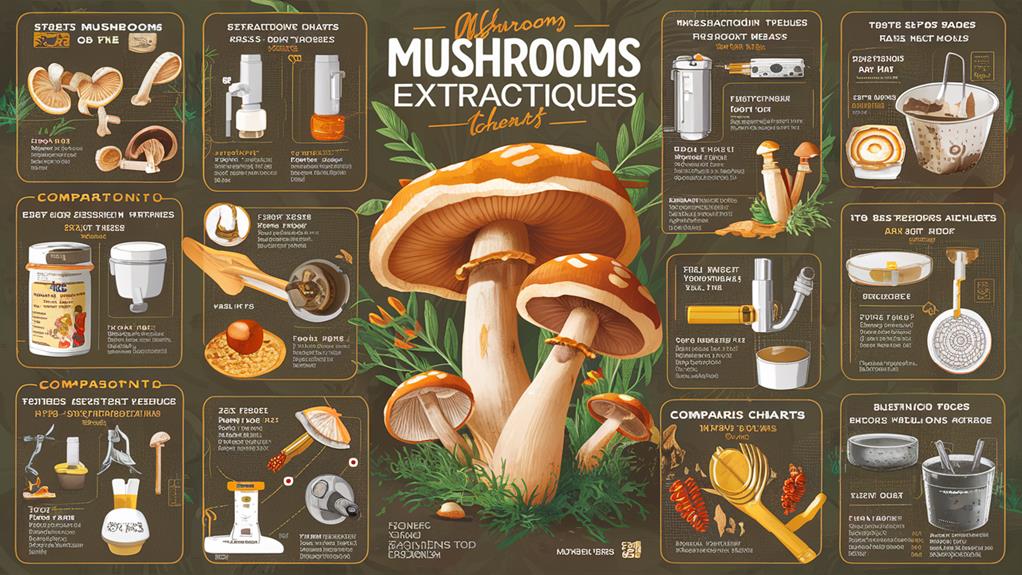
When comparing mushroom extraction techniques, start by understanding the different methods, like hot water and alcohol extraction. Next, evaluate the antioxidant activity of your extracts through various assays, ensuring you get the most health benefits. It's also important to assess purity and safety, as these factors impact the effectiveness of your compounds. Consider extraction efficiency, cost, and scalability, especially if you're producing in larger quantities. Don't forget to investigate the environmental impact of your methods. Lastly, ensure compliance with local regulations to guarantee safety. By exploring these tips, you can make informed choices about extraction methods that suit your needs.
Understand Extraction Methods
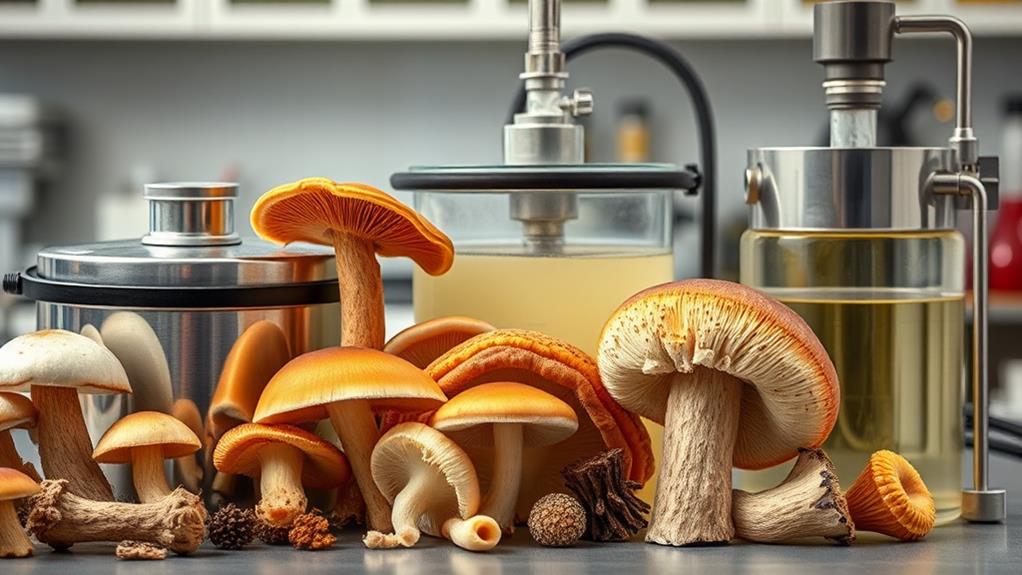
Extraction methods are crucial for unlocking the health benefits of mushrooms. When you look at mushroom extracts, you'll find that different techniques affect the extraction of valuable antioxidant compounds.
Hot water extraction is one popular method that effectively pulls out water-soluble polysaccharides, like beta-glucans, which support your immune system. This method is particularly effective for mushrooms rich in water-soluble nutrients, such as Turkey Tail and Lions Mane, allowing for enhanced therapeutic properties against various health conditions.
On the other hand, alcohol extraction targets alcohol-soluble compounds such as terpenoids and phenolics, which also offer significant health benefits maximizing bioactive compounds.
If you want to maximize the advantages of mushrooms, consider dual extraction. This approach combines hot water and alcohol methods, resulting in a comprehensive tincture that includes both water-soluble and non-water-soluble compounds. It's like getting the best of both worlds!
Don't forget the impact of your extraction technique. For instance, using acidic water has shown better efficiency in extracting polyphenolic compounds than other solvents.
Additionally, if you're working with hard mushrooms, using a coffee grinder or sausage grinder can enhance the process. By increasing the surface area, you allow more solvent interaction, leading to richer and more effective mushroom extracts.
Understanding these extraction methods can help you make better choices for your health!
Evaluate Antioxidant Activity
Mushroom extracts consistently exhibit varying levels of antioxidant activity (AOX), which can be assessed through different assays like ORAC, DPPH, TPC, and FRAP. Each method measures antioxidant capacity in unique ways, helping you understand how effective different extraction techniques are at retaining bioactive compounds.
For instance, laboratory-prepared extracts from mushrooms like I. obliquus and G. frondosa show significantly higher AOX activity compared to commercial ones. The choice of extraction method is crucial, as different extraction techniques can yield distinct profiles of bioactive compounds, influencing their antioxidant potential.
The extraction method you choose can greatly influence the Total Phenolic Content (TPC) and overall antioxidant activity. It's essential to consider factors like solvent choice and extraction duration, as these can optimize the antioxidant potential of your extracts.
You'll find that specific species, such as chaga and maitake, consistently demonstrate superior antioxidant activity, making them excellent options for your experiments.
Interestingly, laboratory-prepared chaga extracts maintain stable AOX for up to a month, while commercial extracts may lose their effectiveness after just one day.
Assess Purity and Safety
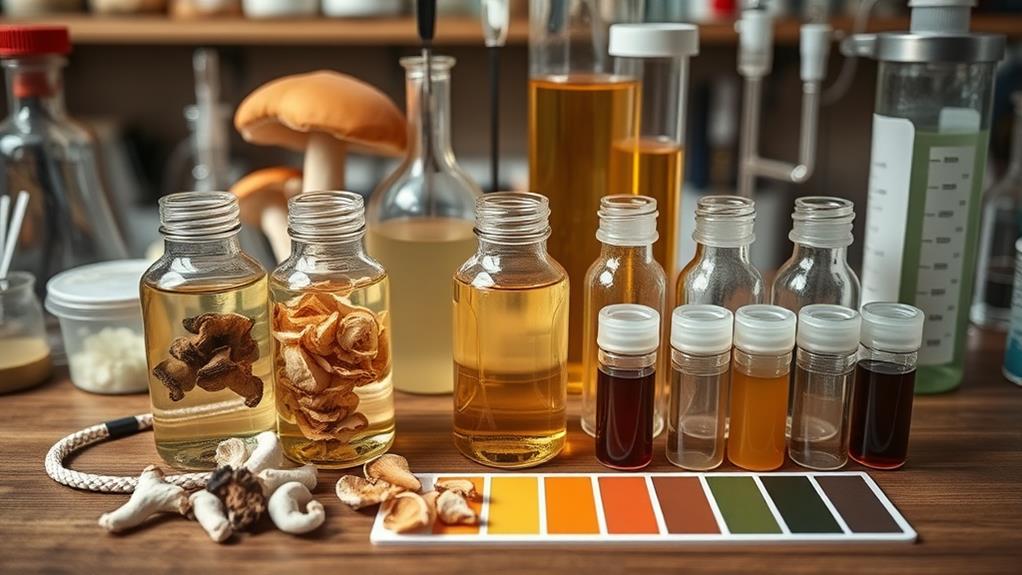
When evaluating the purity and safety of mushroom extracts, it's vital to consider the extraction method employed. Different techniques can produce varying levels of bioactive compounds, impacting both purity and effectiveness. For instance, dual extraction methods often yield a broader spectrum of beneficial compounds compared to simpler methods, enhancing extraction efficiency.
Safety is equally important. Always check that the solvents used during extraction, like food-grade alcohol or hot water, are safe and non-toxic. Harmful residues can compromise the quality of the final product.
You should also look for third-party lab testing results. These tests confirm that no contaminants are present and verify the potency of the extract. It's a reliable way to ensure that what you're consuming meets safety standards.
Additionally, consider the source of the mushrooms. Wild-foraged varieties may have different purity levels than those cultivated under controlled conditions.
Lastly, research how stable the extract is over time. For example, hot water extraction typically provides stable compounds that maintain their potency longer, which is essential for getting the most benefit from your mushroom extract.
Consider Extraction Efficiency
Understanding the extraction efficiency of various methods is key to maximizing the benefits of mushroom extracts. Different extraction techniques yield varying amounts of bioactive compounds. For example, hot water extraction is excellent for capturing water-soluble polysaccharides like beta-glucans, which are vital for their health benefits.
However, if you're interested in non-water-soluble compounds, such as terpenoids and phenolics, you might want to consider alcohol extraction instead.
Interestingly, dual extraction methods combine both hot water and alcohol extraction, providing a comprehensive yield of both water-soluble and non-water-soluble components. This method can significantly enhance the total phenolic content (TPC) and antioxidant activities of your mushroom extracts.
In fact, aqueous extracts often show the highest TPC values, which are crucial for maximizing antioxidant benefits.
Using techniques like principal component analysis (PCA) helps distinguish between different groups of mushroom extracts based on their antioxidant properties.
Analyze Cost and Scalability
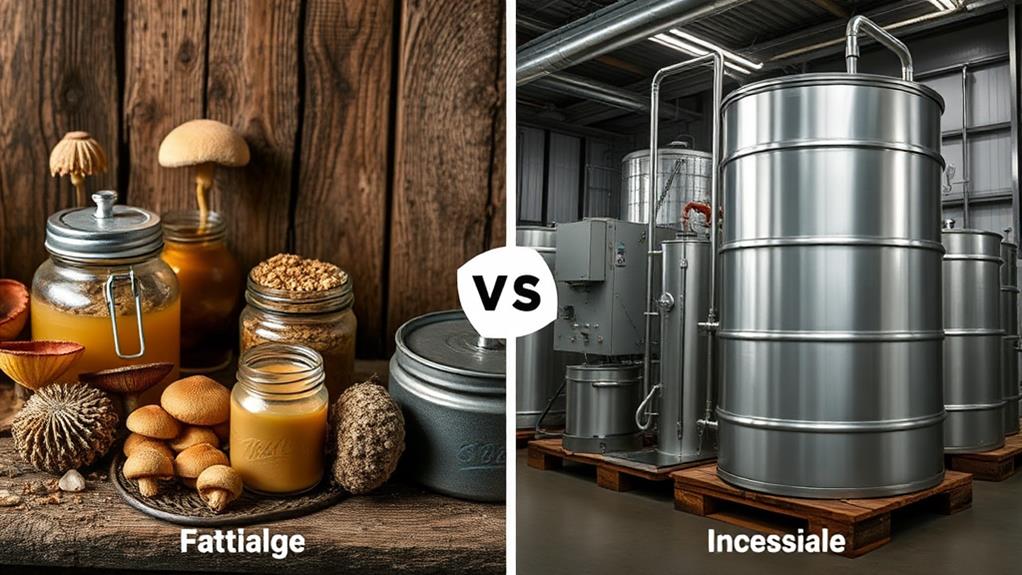
Cost and scalability play crucial roles in selecting the right extraction technique for mushroom products. You need to consider both the cost efficiency of the method and how well it can grow with your production needs. Here are three key points to help you analyze these factors:
- Extraction Method Costs: Hot water extraction is typically less expensive than alcohol extraction. This means it's more accessible for small-scale producers who may not have the budget for specialized equipment.
- Scalability of Techniques: Dual extraction methods can yield higher quantities of bioactive compounds, making them suitable for larger operations. While they may be more complex and time-consuming, they can significantly boost your production capacity.
- Labor Costs and ROI: Automated alcohol extraction systems can cut labor costs over time. They do this by speeding up the process and allowing you to handle larger batches without needing more workers. This can improve your return on investment, as higher concentrations of beneficial compounds often lead to better market prices.
Investigate Environmental Impact
When you look at mushroom extraction techniques, it's essential to consider how they impact the environment.
Sustainable sourcing practices can reduce waste and promote healthier ecosystems, while energy consumption analysis helps us understand the carbon footprint of each method.
Sustainable Sourcing Practices
In recent years, sustainable sourcing practices for mushrooms have gained significant attention as we aim to balance culinary desires with environmental responsibility.
By focusing on sustainable methods, you can enjoy medicinal mushrooms while also protecting our planet.
Here are three key practices to consider:
- Selective Foraging: When foraging, collect mushrooms carefully. Leave some behind to ensure populations can regrow, which helps maintain biodiversity in their natural habitats.
- Cultivation Alternatives: Opt for cultivated mushrooms. These can be grown using agricultural byproducts, reducing pressure on wild populations and allowing for a more sustainable extraction process.
- Organic Farming Practices: Choose mushrooms grown using organic methods. This minimizes pesticide and chemical runoff, preserving soil and water quality, which is essential for a healthy ecosystem.
Implementing these sustainable sourcing practices not only benefits you but also contributes to the overall health of our ecosystems.
Mushrooms play vital roles in nutrient cycling and soil health, so your choices matter.
Energy Consumption Analysis
Sustainable sourcing practices not only focus on the ecological balance but also extend to the methods used in mushroom extraction, where energy consumption plays a significant role in environmental impact.
When you consider hot water extraction, it often requires prolonged boiling times, leading to high energy use. In contrast, alcohol extraction may be quicker but can still be energy-intensive due to the need for high-proof alcohol, which involves distillation and purification.
Moreover, dual extraction, which combines both hot water and alcohol methods, can be the most energy-consuming option. This method requires heating water while maintaining the alcohol extraction simultaneously.
However, there's a silver lining: you can turn to automated systems. These systems optimize the extraction process, reducing energy consumption by minimizing heat loss and increasing efficiency compared to manual methods.
To further lessen environmental impact, adopting sustainable practices is crucial. Using energy-efficient equipment and renewable energy sources can significantly lower the energy costs associated with mushroom extraction.
Review Regulatory Compliance
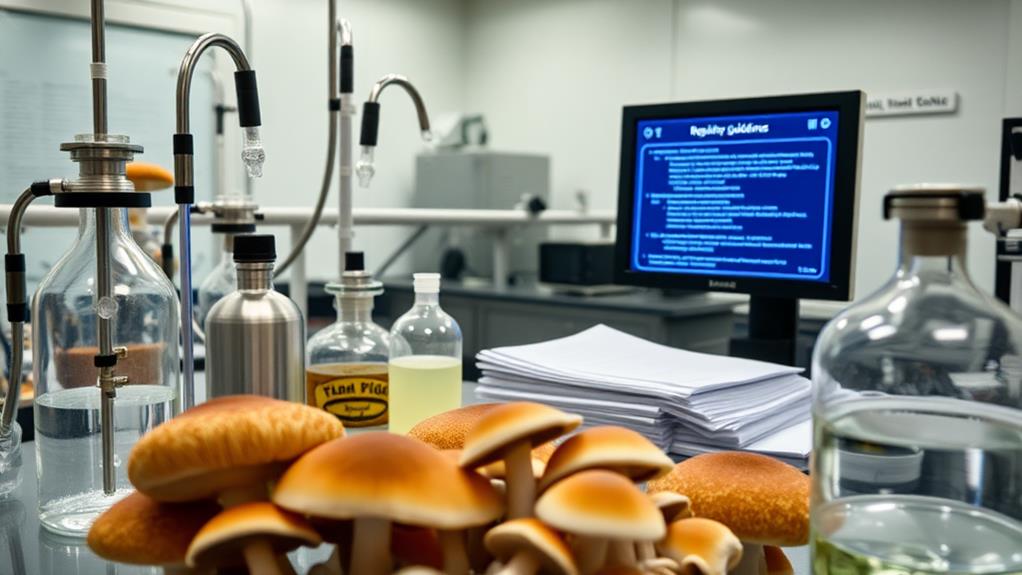
Navigating the complex landscape of regulatory compliance is crucial for anyone involved in mushroom extraction. Ensuring your extraction methods align with local regulations is essential, particularly regarding food-grade solvents like alcohols and acids. This helps you avoid legal issues and guarantees consumer safety.
Here are three key points to consider for regulatory compliance:
- Know Your Guidelines: Familiarize yourself with the specific regulations set by health authorities in your region. These requirements can differ significantly, so it's vital to stay informed.
- Document Everything: Keep thorough records of all extraction processes and results. This transparency is essential for regulatory inspections and builds trust with your consumers.
- Consider GMP Certification: Good Manufacturing Practices (GMP) certification can enhance compliance and ensure product quality. This step can also improve your marketability.
Staying updated on any changes in regulations surrounding the extraction of bioactive compounds from mushrooms is important.
Conclusion
In conclusion, comparing mushroom extraction techniques isn't just a task; it's an adventure into the world of nature's wonders. By understanding various methods and their impacts, you can make informed choices that benefit both your health and the environment. Remember, every decision counts, so take the time to evaluate antioxidant activity, purity, and efficiency. With this knowledge, you're not just a consumer; you're a protector of quality and sustainability in the mushroom industry.
